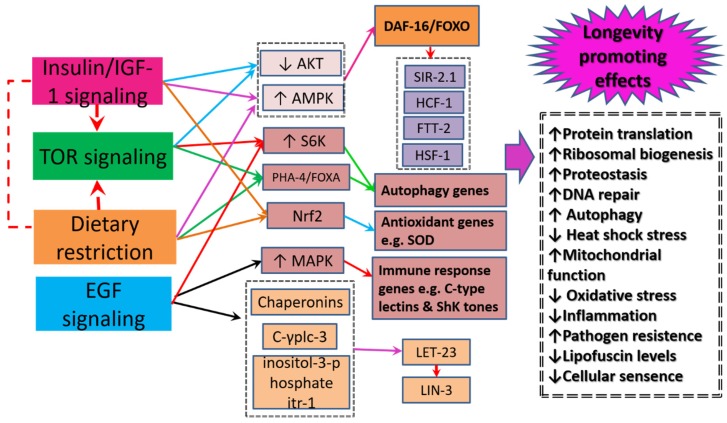Figure 3.
Probable mechanisms through which royal jelly (RJ) and its components extend lifespan. RJ reduces insulin/insulin-like growth factor-1 signaling (IIS), which heightens the activity of DAF-16—the C. elegans counterpart to the mammalian Forkhead Box O transcription factor (FOXO). Activation of DAF-16/FOXO promotes its translocation from the cytoplasm to the nucleus and fosters interactions with its associated transcriptional co-regulator proteins: host cell factor (HCF-1), sirtuin homologue (SIR-2.1), and FTT-2 (a 14-3-3 protein). This results in formation of protein complex inside cells and enhancement of the expression of multiple longevity promoting genes as well as regulation of downstream process of dietary restriction signaling (which lowers food-intake) and the mechanistic target of rapamycin (mTOR) pathway by extending the lifespan of the control unc-24/+ mutants. The interplay among several genes involved in IIS, mTOR, and dietary restriction signaling boosts key longevity-related cellular processes: DNA repair, autophagy, antioxidant activity, anti-inflammatory activity, stress resistance, and cell proliferation. On the other hand, RJ activates epidermal growth factor receptor (EGFR) signaling mainly by activating its receptor (LET-23). EGFR functions via downstream phospholipase C-γplc-3 and inositol-3-phosphate receptor itr-1 to upregulate elongation factors and chaperonins, which increase protein translation and proteasome activity—a mechanism that entails rebuilding cellular components; enhancement of cellular detoxification, ribosomal function, and muscle maintenance; and reduction of lipofuscin levels (age-pigments that accumulate during senescence).

